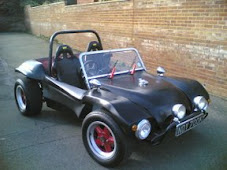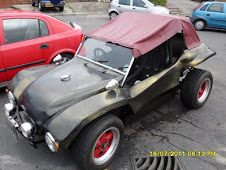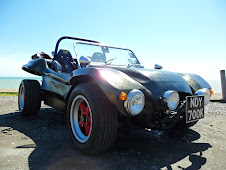 30th January 2011
30th January 2011The last day but one of January brought temperatures of 2.5 degrees outside and I knew i had a lot of fibre-glassing to do, which I knew would not be easy to achieve at these low temperatures.
The body work was starting to come along as it was slowly being rubbed down. I had always new that the design of the Fibrefab SWB Rat was very light and that some areas moved when the car was on the road. The worst of these was the front wings and headlights. In addition people for some reason think they can sit on car wings which on this type of buggy is not possible as the wings are not strong enough. With this in mind I had decided that with the body work off I could manage to build a mount that would hold the wings more rigidly. I bought some stainless steel fastenings from an online store these at first seemed difficult to loca
 te as I new i wanted to fibre-glass a block of wood into the wing with some hidden bolts to mount the frame support. The main problem with this is that it is very difficult with a hidden bolt to stop the head spinning when you tighten it. I located some coach bolts that had a square on the underside of the cup. along with this I found some bar that was drilled with 8mm holes in a chain, 205 mm long and 19mm wide. I found that I could make these holes square with a file so that the head of the coach bolt would be captivated in it. I also bought some oak that was wide enough to
te as I new i wanted to fibre-glass a block of wood into the wing with some hidden bolts to mount the frame support. The main problem with this is that it is very difficult with a hidden bolt to stop the head spinning when you tighten it. I located some coach bolts that had a square on the underside of the cup. along with this I found some bar that was drilled with 8mm holes in a chain, 205 mm long and 19mm wide. I found that I could make these holes square with a file so that the head of the coach bolt would be captivated in it. I also bought some oak that was wide enough to take a channel to sit this metal work into. I used a router to cut this channel and assembled the two fixings easily. I used a DA to clean the underside of the wing back to the fibre-glass. This would provide me with a location to bolt to on the underside of the wing. I used hairy fibre glass filler to bond the wooden anchor points onto the underside of the frame. After bonding the wooden anchors on by filling the groove up with filler and then mating them onto a bed of filler I managed to build up enough hairy filler to make the bracket slope into the underneath of the wing. I had nearly completed both anchors when I realized I was running out of filler. I would have to wait for this to dry and purchase some more filler to complete smoothing them into the wings.
take a channel to sit this metal work into. I used a router to cut this channel and assembled the two fixings easily. I used a DA to clean the underside of the wing back to the fibre-glass. This would provide me with a location to bolt to on the underside of the wing. I used hairy fibre glass filler to bond the wooden anchor points onto the underside of the frame. After bonding the wooden anchors on by filling the groove up with filler and then mating them onto a bed of filler I managed to build up enough hairy filler to make the bracket slope into the underneath of the wing. I had nearly completed both anchors when I realized I was running out of filler. I would have to wait for this to dry and purchase some more filler to complete smoothing them into the wings. With the body work upside down I also noticed that the underside of the shell did not mate as well as it could do. I used the the body kit frame on the underneath of the body to improve the angles of the back transom. This was really a try bit by bit operation , which |I must confess was a little easier than mating it to the chassis. used the DA to cut the body work down . It was to high were I had made it up with fibre-glass and improved it significantly by this trial and error approach. There was some areas that needed making up with 5mm of filler so I knew my visit to buy more fibre-glass filler was going to have to be very soon.
With the body work upside down I also noticed that the underside of the shell did not mate as well as it could do. I used the the body kit frame on the underneath of the body to improve the angles of the back transom. This was really a try bit by bit operation , which |I must confess was a little easier than mating it to the chassis. used the DA to cut the body work down . It was to high were I had made it up with fibre-glass and improved it significantly by this trial and error approach. There was some areas that needed making up with 5mm of filler so I knew my visit to buy more fibre-glass filler was going to have to be very soon.With the 1.8ml tub of Fibre filler purchase I started work making
 up the back section . I knew this was going to be an overnight hardening process so set about making good with the filler using a straight edge to ensure the angles where good and straight . I also
up the back section . I knew this was going to be an overnight hardening process so set about making good with the filler using a straight edge to ensure the angles where good and straight . I also filled the center area so that it could be cut back to fit the body kit tighter. You can see the result of using the fibre filler really improved the back section. The drying time for this filler is usually 20 mins and I new as the temperatures was very low that there was not much chance of this drying other than over night.
filled the center area so that it could be cut back to fit the body kit tighter. You can see the result of using the fibre filler really improved the back section. The drying time for this filler is usually 20 mins and I new as the temperatures was very low that there was not much chance of this drying other than over night.The next morning I returned and applied more fibre fill to th
 e front wings to smooth out the wing around the mated on block. I
e front wings to smooth out the wing around the mated on block. I  built up the edges with fibre fill so that the gradient between the block and the wing was smooth making the block disappear into the fibre glass wing. I new this would take a long time to dry out so left the fibre fiiller over night to really harden up. The smooth finish I would need to coat with a skin of fibreglass mat to seal it in from the weather. I new that the filler would need to harden off and that it needed to be totally dried out before this was applied.
built up the edges with fibre fill so that the gradient between the block and the wing was smooth making the block disappear into the fibre glass wing. I new this would take a long time to dry out so left the fibre fiiller over night to really harden up. The smooth finish I would need to coat with a skin of fibreglass mat to seal it in from the weather. I new that the filler would need to harden off and that it needed to be totally dried out before this was applied.


































